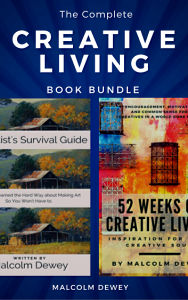I am a returning artist struggling to make a sale, I am not sure if it is my paintings, price, subject or my selling techniques. Any help greatly appreciated. Albert A recent comment from a visitor to this blog, quoted above, struck me as a universal statement for any artist trying to make a go of an art career. When artists get down on themselves it is often verbalised along the lines of "I am not making sales, because my art is not good enough" or "If I can sell ___x___ paintings this weekend I am OK" When the target is not met then there is a convenient exit ready and waiting.
The truth must be faced before we can get into career strategy. In truth an artist needs recognition at a fundamental level. This gets confused with sales as a yardstick, but this is a mistake. Sales alone will not fill the need for recognition. A better way of saying this is that the artist needs to know that his art has meaning. The trap with sales as a yardstick is that the artist becomes attached to numbers and when they do not add up to a certain sum the artist takes this as a rejection. If its numbers you are after then there will never be enough. I know a few artists (I use the word loosely) who knowingly churn out paint-by-numbers style works for the quick sale. They freely admit to this and laugh it off. The problem is that they are not selling art. There is no true communication. It is a lie and they are caught up in a numbers game that is now their life. If they do not get back to the truth of art they will fade away disillusioned. Art is firstly a form of communication. The meaning of communicating through art is achieved when the artist's efforts are recognised. Painting sales alone will never fill the artist's soul. So when we are not attached to sales as a yardstick we can accept the ups and downs of business a lot better. It is not the artist's talent that is at fault. If no sales take place then artists must make business decisions to rectify the situation. Not throw their hands up in despair and curse their imagined lack of talent. Let me add that improving skills and quality of art is a business decision too. These are learned qualities through effort not a marker for abundance or lack of talent. Artists have the talent, but must add the sweat. Attachment to an outcome leads to frustration. Reality and our imagined outcome seldom meet halfway. Instead if we focus our efforts on doing the work as best as we can with a lightness of spirit we will not fall into the trap. Artists will benefit from calmer minds and they will be kinder to themselves. Their work will improve consistently. This idea of non-attachment is not easy especially over the long haul. Our commercial world has seen to that. Being aware helps to foresee trouble so that we can head it off. If the artist stumbles over a bad habit like feeling sorry for himself then it will also be easier to pull himself out of it and get back to work. There is no communication if there is no art. Once the art is produced it must be shared and once shared a connection is made, which in turn brings meaning to the artist's efforts. So the goal is to improve the artist's communication through art to a wider audience on a regular basis. This must be the intention. It is not accidental. Collectors seek communication with an artist too so step one is to get the conversation going. (In Part 2 we will look at strategies for getting ready for the market) This post is about art in general, but more of a pressure valve type of article. Hopefully I can tie it all up neatly in the end. The thing is our country has a way of making me optimistic, confused, hopeful and despair all at once. I know that I am not alone on this. From what I can see online on blogs, comments and news items there is a huge well of potential in South Africa. An energy that is going to make this country truly awesome.
Looking at the world we have seen EU economies shaking up the financial world. Cyprus of all places sneezed last week and the markets caught a cold. Crazy! It is also so very banal. Where is the excitement among the youth, the sense of forging new paths? Certainly not in Old World Europe where disillusionment seems to be at an all time high. South Africa has all the excitement and potential for making something new. We have to stop waiting for permission and approval. We also need to forget about waiting for leadership. Find a mentor rather and learn from someone who has passion for his or her craft whatever that may be. People need jobs - sure, but more importantly people need a passion for something. Maybe if passion is the yardstick then the jobs take care of themselves. Self-employment suddenly seems viable. Pursuing your own destiny is now the new watchword, but this does not mean you can remain in isolation either. Connect and share. Give freely where reasonable. Expect nothing in return and you will still receive. Use the new tools, think creatively and do the work. Provided these elements are met we all stand a good chance of doing something meaningful. We may have to moonlight at first, but passion will win the day in the end. Want to learn to program? Take a free university course online. Yes I said free. I am seeing many young creative folk successfully taking on the world let alone their local market. The entertainment world, arts and business are all well represented with new stars. You will probably find their art on You Tube or some other social network being given away. They are patient and determined, but not too attached to the outcome. As a result they are making it big. These young lions are not waiting for government to solve their problems. They do not believe in corporate ladders or pensions either. Many more will start to follow the examples of their peers. The older generations? Grey wolves are going back to work on their passion businesses. Selling crafts on Etsy. Connecting online and giving workshops or learning new skills. It seems mowing the lawn and collecting a pension is not the dream anymore. Shame on the 20th century for selling that idea! The point I guess comes down to what you do with your time on this little blue planet. Did you think that you could never paint? Had no talent for the guitar? Want to learn to run a business, but cannot pay for lessons? No problem. You can do all these things now and share your passion with others who are waiting for you to start. That makes me optimistic. 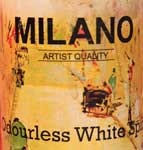 A few weeks back I posted an article comparing oil paints. During research on the topic I was interested to read about health risks associated with artist materials. Recently I also happened to be talking to an artist and he mentioned two artists who were afflicted with Parkinson's disease. Although these artists lived normal llifespans it was noteworthy that they shared this disease too. Since exposure to solvents increases the risk of contracting Parkinsons maybe it was time to relook at basic studio safety. It is well known that paint commonly used by the impressionists, for example, had lead content. The paint tubes were made from lead, which did not help. There was also the risky use of zinc in zinc white. These toxins were absorbed through the skin or ingested accidentally posing a higher risk. It has been suggested that Van Gogh even ate paint during his health problems. Not helpful! Fortunately lead and zinc usage in paint has been eliminated or at least, in the case of zinc, reduced and altered to safer proportions. Zinc still poses risks so use with caution. What about solvents? The use of solvents to clean brushes is difficult to avoid for oil painters. There are water based oil paints coming onto the market, but traditional linseed oil based paints are still the most popular. The problem with solvents is that they can be absorbed through inhalation and through the skin. Hydrocarbons and petroleum distallates are the hazardous byproducts of these solvents. Consider this article by Michael McCann for a comparison of solvents and their risks. Remember that solvents include mediums such as liquin and other artist's mixing agents used to speed up or reduce drying times. Also note that alkyd additives to paints is growing in popularity as it speeds up drying time. Alkyds are also toxic so the usual precautions apply. The most important point is to use good quality artists spirits that are entirely odourless. I have encountered artists using hardware store solvents that are not odourless. Not only do these intense odours induce headaches, but the volatile chemicals are inhaled and absorbed posing high risk of poisoning. Like I said the spirits should be entirely odourless not simply reduced in odour. You will sometimes find these cut-price solvents advertised as artist's spirits. Do not buy them. Citrus based spirits are also available and these are less risky too although more expensive. Next tip is to use small amounts of solvent while painting. Much of the paint can be removed with tissue paper during your painting. Use several brushes too so that you do not muddy up lights and darks using the same brush. This will help to reduce the amount of solvent cleaning required in a painting session. You can also get good results using a bit of olive oil. Massage the brush into a little olive oil then clean off with tissue. Safety is also increased if you use latex gloves while painting and cleaning brushes. I was hesitant about using gloves at first. I thought the gloves would feel odd and distract me, but actually I barely noticed them. Gloves also make cleaning up a cinch and save me hassle when painting outdoors especially when I have to drive back home - there is always paint getting onto the steering wheel! Latex gloves are cheap and available in bulk at the supermarket so it was no hardship to add this to my set-up. When in the studio make sure there is sufficient cross ventilation. Do not let wastebaskets pile up with solvent and paint covered rubbish. Dispose of these items the same day. Avoid sanding dried paint off panels as the particles will be inhaled. So need to get into a panic. A bit of common sense and a few precautions is all it takes. Please add your artist safety tips or comments below. 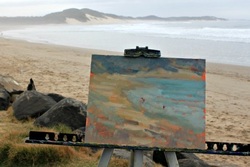 Starting a quick study Saturday morning very often means one thing in suburbia - shopping day. Of course there are a few people who will argue that they do more than shop, but the throngs of cars heading to the malls suggests shopping is big. This activity is a necessary evil yet I am not alone in trying to minimise the impact shopping has on my precious free time. I am blessed in having a wife who shares these sentiments. We will be the ones waiting outside the shop's doors as they are opened by bleary eyed shop assistants. The aim being for us to get in and out as fast as possible before the crowds arrive. This past Saturday was an exception. Neither my wife nor I could face this weekly expedition. The weather was cool and the wind was absent for a change. Only one thing for it - grab the paint kit and head off to the beach for a an hour or three of painting. This was not entirely selfish since my children came with too and they could get some fresh air while I did my thing with the paints. My choice was well rewarded. Several other people had come down to the beach too and there was a good deal of surfers taking advantage of the magnificent waves. If this sounds idyllic then let me confirm it - it really was fantastic. A moment where time flies by as you become lost in doing something you love. Soon into my second painting I noticed a gent emerging from the surf who had been boogie boarding. Turns out he was on retirement and had started painting. He joined me to chat about art and we shared a few stories about our favorite topic. Thanks for the chat Brian and I hope to paint outdoors with you sometime. 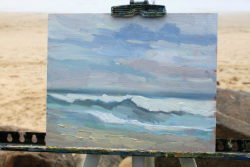 Mixing and placing colour notes A few things learnt on that morning:
Or you could try shopping at the mall instead. Nah! The business of art today challenges artists to be innovative while new opportunities open up for collectors who break through old comfort zones. Let us agree that professional artists need to find collectors to purchase their work and collectors are looking for art they love at a good price. In the old days (lets say the early 2000's) these artists needed galleries to stand a chance of finding a collector. Now with the internet taking off there is almost limitless opportunity for artists to market their work. Even galleries are going online and doing very well this way. But online marketing is one option to be added to traditional marketing.
In a recent mini-survey I asked my newsletter readers about their online art purchasing concerns. The majority view was that the risks seemed to outweigh the benefits. This was indeed a surprising outcome and a bit worrying for me too. Aside from a tight economy the concerns mentioned can be summarised as follows: - hacking of bank information - the online photo has been manipulated (or other misrepresentation) - the art will not arrive or at least it will be damaged All of these concerns are of course possible issues, but then again these issues apply to any commodity sold online. Banking is also probably one of the most popular online services used. We know that internet sales of consumer goods has exploded in popularity. Indeed many internet users, for example, try to do all their Christmas shopping online. Makes sense when you consider the vast choice, convenience, no commute and time saving involved. Let us look at these concerns more closely. Hacking is possible, but unlikely in the scheme of things. It is more likely that we will lose our credit card than have it hacked. The biggest threat is faced by the gullible in phishing scams. With a bit of common sense this threat can be avoided. Also artists usually will accept EFT transfers as it is safer and more cost effective. So collectors need not use credit cards at all. Getting closer to the big issue - the manipulated photo or other misrepresentation. The best way to avoid this is to get to know the artist as best as possible. E-mail and even phone the artist if this is practical. Check up on the artist's track record. Any legitimate artist trying to build a career will be desperate to prove his or her credibility. Why mess this up with photo fraud? If the artist seems like a scammer then click your way out of there! Also make sure there is a money-back guarantee. Will the art arrive safely? A track record of sales and satisfied collectors should dispel this concern. Find out how delivery will take place. A reputable courier service is a must these days. I have bought artworks online and confess that I have always been blown away by how much better the artwork looks in reality than online. This stands to reason, but also poses a challenge to artists. How to give collectors a better feel for the painting's appearance than with a small photo. One option is to offer a high resolution photo that can be e-mailed on request to the collector. Artists should not worry about image theft. That is unlikely to occur and if so then so what? Nothing compares to the original. Many photos can be sent showing size comparisons and frames. It is worth the artist's time to do this and the collector need not be shy to ask. The benefits for both parties are clear. The artist gets a sale with low overhead and the collector gets ample choice and at a good price too. So the challenge is for both artist and collector to do their homework, prepare the basics and have a worry free experience. It should be the start of a beautiful relationship! Recently I received an e-mail from a third year university art student . This student told me his subject majors and then proceeded to ask me for employment after he graduates this year. I am always happy to hear from other artists sharing their experiences and so forth, but this was a first for me. Clearly I am in no position to hire other artists. Perhaps Damien Hirst needs artists to manufacture his next installation, but my studio has to make do with me flying solo.
Sure I do appreciate that income is critical for so many. I do assume that the purpose of a degree is to prepare one for some sort of independence to earn an income. Naive I know. A day job does give a measure of security. It was not always this way. There was a time when you were your own boss first - especially artists. Everything changed when the world became geared to churning out employees. That was the model from the industrial revolution and it worked wonders for two hundred years. Factories can churn out widgets by the thousand using machines and basic skilled labour to pack the widgets or sort them on the conveyor belt. Managers would make sure targets were met. Accountants would tally up debits and credits and lawyers would keep the paperwork in order. But all of this order was shaken up by globalisation and the internet. Fanatical new economies rose up and threatened the happy dream. Now pensions and job security are disappearing. We need to be our own expert and general practitioner again. Every tool necessary for self-fulfillment is available to us. Artists should know this, but have we been dreaming too? Have we been fed the idea that all you needed for success is an art degree, some paintings and a gallery will snap up your work and you will be set for life. Maybe add a bit of controversial behaviour to get attention until sales are steady. Was this student under the impression that a job was necessary to take off with his career? It is possible perhaps to land a plush mentorship with a big name artist or maybe an assistant in a metropolitan gallery, but highly unlikely. What did this suggest about the art degree and our education system? Was this student not taught the fundamentals of marketing and business so that he could stand up for himself in the big world out there? What about the talent within that young artist - genius even - that needed to be unleashed from the confines of academe to take the world by storm? If the youthful artists are not doing this then who will? The old system of jobs and security is long gone. There is no security in the gallery system either. The established galleries are hanging on, the rest have closed down and self-marketing has taken care of the vast bulk of artists out there. Today a gallery may get twenty people in a day browsing through. But online an artist actively marketing his work may get three thousand visitors. Yes there are challenges using this approach, but the numbers do not lie. The system has changed forever. On the bright side we now have opportunity. It is time that all artists forget about security in a system long dead and embrace the freedom that being an artist suggests. Stand up for yourself and make your way by doing good work and setting your own course. Join the new artist community page especially for South African artists. Share your art and the story behind it. View here
There is no point in continuing with a flawed painting. Life is too short. Learn your lessons and move on, wiser and stronger. (anon) Art is never finished, only abandoned. (Leonardo da Vinci) A life spent chasing other people's approval is a life spent on a pointless roller coaster of emotional highs and lows, without ever knowing yourself. (Rinatta Paries) The old joke is that there are two people necessary to complete a painting. The artist to paint it and someone to drag the artist away when the painting is done. Richard Schmid, the famous American artist jokes in his book, Alla Prima, about receiving gentle threats from his loved ones should he not stop on a particular painting for risk of ruining it. There are other reasons to quit too. Not least of which is that the painting is already ruined or even that it had not a chance from the get go. Recognising the critical moment is the elusive key.
"Do not consider your painting finished unless it is exactly what you want to see. If you feel that you are not skilled enough to do that, take the time and trouble to learn what it is you need to know to do it" says Schmid. These are tough words from the master artist. A reminder to us all that the path to accomplished painting is a long one. When I am facing a slump in my painting it can be difficult to pull myself out of it if I dwell on the learning that still lies ahead. So I find it best to take a break and usually by the next day a solution to the problem shows itself. There is always a solution if you keep your mind open to this idea. Even though there is a solution this does not necessarily mean I can plough on with a flawed painting. The solution may require scraping the whole thing down and starting over. If that is what it takes then I do not hesitate. If the previous attempts have dried and scraping is not an option then out the painting goes. Learn from it and move on. These dogs are not pets - they must be released! The typical painting killers are: No concept - this means there was no idea of what the artist wanted to achieve. What do you want to say about your subject? If your concept is clear you will have an idea of what the focus area of the painting is. Concentrate on the focus area and leave the rest of the painting loose. Nothing can be achieved by rendering the painting in detail from the canvas's edge to edge. Not enough preparation - for the beginner this can include fundamentals like notan sketch, outline drawings and value studies. All these missed steps lead to poor composition, weak colour and aimless pushing of paint around the canvas. Too uptight - once the groundwork is done then crack on and paint quickly and with purpose. Wet-into-wet still works best. When we let a painting dry over a week or so it is difficult to get back into it. It is like starting all over again and much changes in the interval. Suddenly the spark of life has left the painting. Overwork - you have made a good start but now you have gone too far. The details are too rendered and the life has given way to overworked stodge. This is common through all painting levels so do not beat yourself up about it. Be aware of the moment when you look at your work and think Wow! that is looking great! It is at that moment when you must consider whether there is anything more to say. Can adding something now actually add meaning to the painting? If not then stop. If in doubt - sleep on it. Next morning the solution may simply be to sign the painting. The above thoughts are not all the issues. What are your painting killers and solutions? When do you know it is time to stop? A comparison between: Winton, Maimeri, Lukas and Zelcol (Student Quality) By Malcolm Dewey Recently an artist mentioned to me that she faced a dilemma when it came to the type of paint to use. Her issue came down to price of the paint and more importantly her lack of belief that she could do justice to better quality paint. It is not the first time I have heard this sad testimony. I once shared these views too and tried some pretty awful paints when starting out. With hindsight I can say that better quality paint does help to make a better painting. Use the best you can afford and have no worries about it. When you complete your breakthrough painting you want it to be with good paint. You will not regret it!
Top Quality Student Paint? This brings me to the subject of this article. What type of oil paint do you choose for your painting? The market has seen several new brands enter art shops. In particular I wanted to look at good quality student paints. The type of paint that a serious part-time artist can use with confidence without breaking the bank. I visited a local art supply shop and picked four popular brands for a comparison test. The paints are Winton's Cadmiun Red hue, Lukas Studio Cadmium Red Light, Zelcol's Cadmium Red and Maimeri Classico Cadmium Red Light. Note on Pricing: Due to the rapidly changing exchange rates, prices have been left out due to constant fluctuations. Except to compare value for money as a ratio between brands. Read the full report below 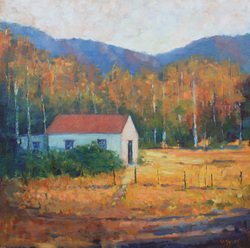 A great frame turns a painting into an occasion. Here is an example of a painting that I recently framed on My Studio page. |
AuthorMalcolm Dewey: Artist. Country: South Africa Archives
June 2024
Categories
All
FREE
|
|

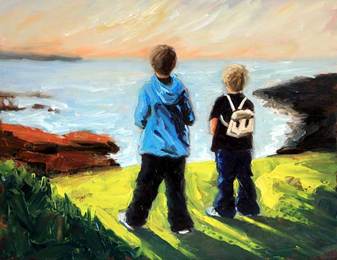
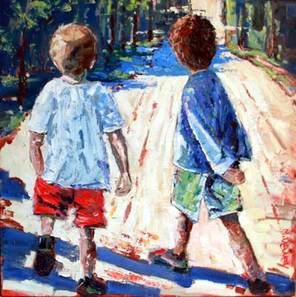

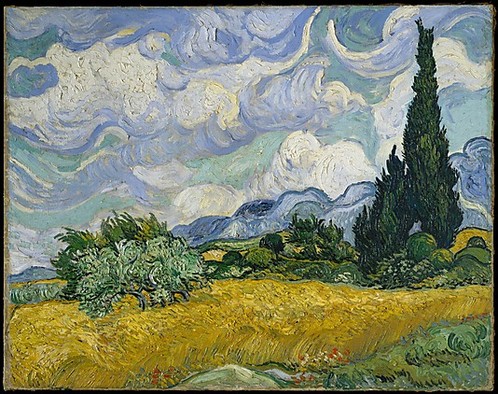
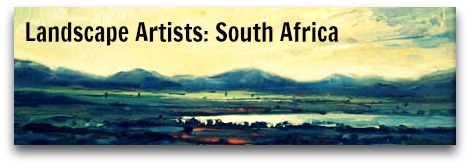
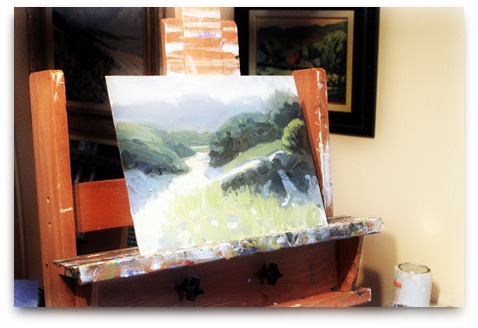
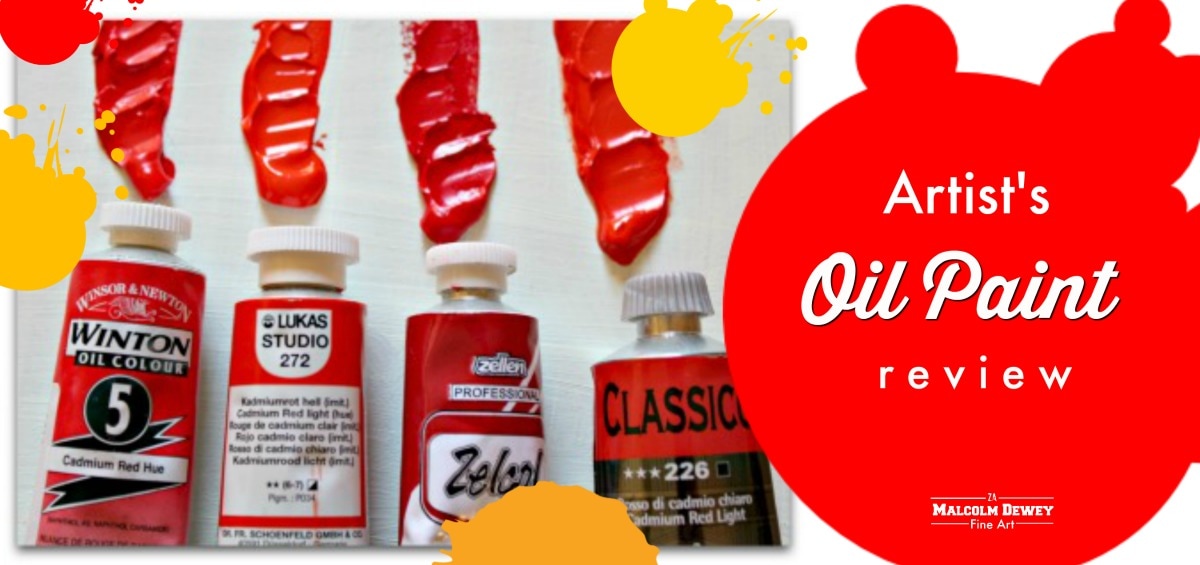
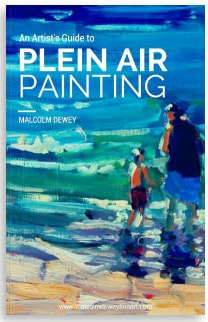
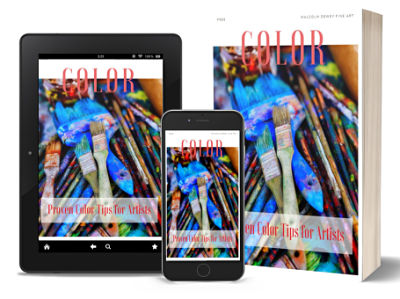
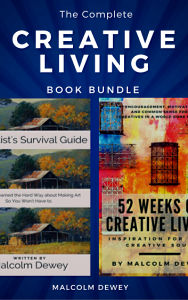
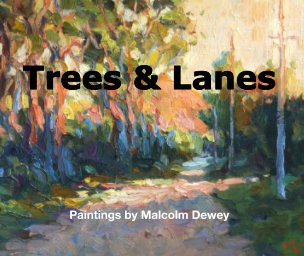


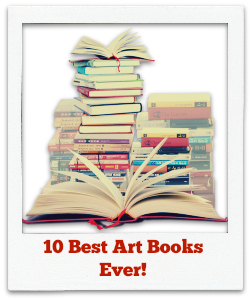
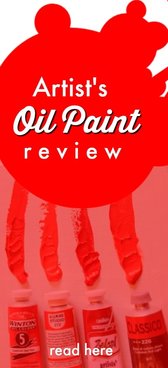
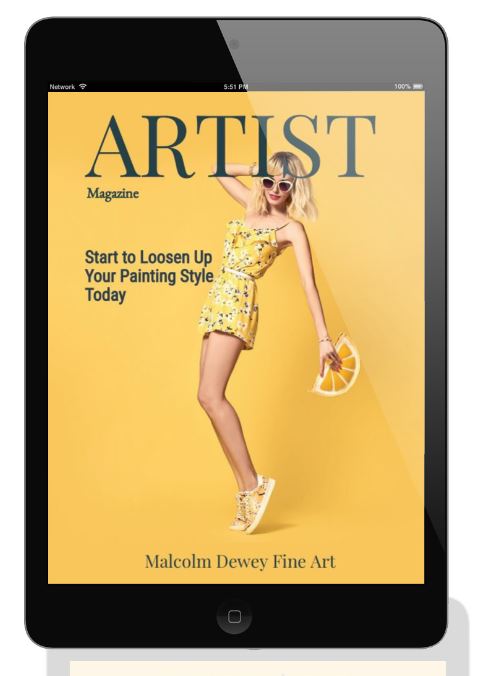
 RSS Feed
RSS Feed

